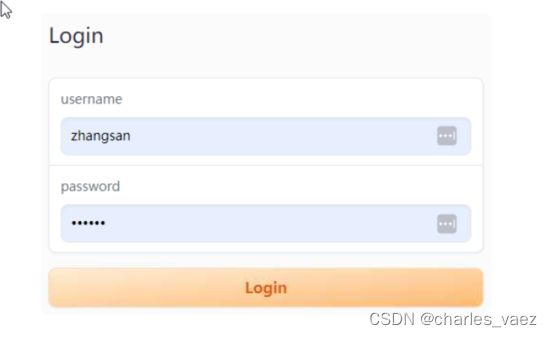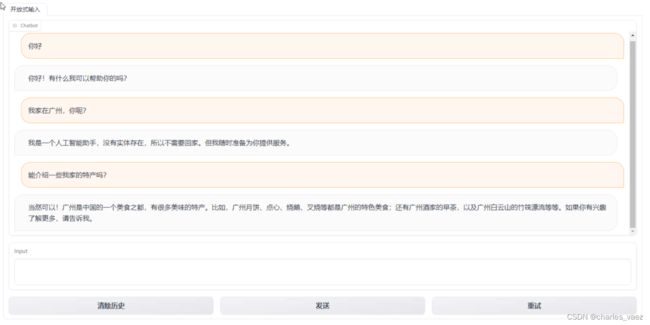开源模型应用落地-qwen模型小试-入门篇(四)
一、前言
通过前面三篇的学习,我相信您已经学会了如何使用qwen模型的基本方法。现在,我们将利用gradio工具,为qwen模型加上一个漂亮的界面,以实现人与机器之间的交互操作。
二、术语
2.1. gradio
Gradio是一个Python库,它可以帮助我们轻松地为机器学习模型创建用户界面。它提供了一个简单而强大的方式,让我们能够通过图形界面与模型进行交互。使用Gradio,我们可以快速地将模型部署为一个Web应用程序或者本地应用程序,而无需编写复杂的前端代码。它还支持文本输入、图像输入和实时摄像头输入等多种输入方式,让用户能够方便地与模型进行对话或者测试。
三、前置条件
3.1.windows操作系统
3.2.下载Qwen-1_8B-Chat模型
从huggingface下载:https://huggingface.co/Qwen/Qwen-1_8B-Chat/tree/main
从魔搭下载:https://modelscope.cn/models/qwen/Qwen-1_8B-Chat/files
四、技术实现
# -*- coding = utf-8 -*-
import os
import logging
import warnings
import gradio as gr
import torch
import sys
import mdtex2html
from transformers import GenerationConfig, AutoTokenizer, AutoModelForCausalLM
warnings.filterwarnings("ignore")
logging.basicConfig(
level=logging.INFO,
format='%(asctime)s [%(levelname)s]: %(message)s', # 指定日志输出格式
datefmt='%Y-%m-%d %H:%M:%S' # 指定日期时间格式
)
root_path = os.path.dirname(os.path.dirname(os.path.abspath(__file__)))
sys.path.append(root_path)
logging.info(f'root_path: {root_path}')
model_name = "qwen-1_8b-chat"
if sys.platform == "linux":
model_path = f"/data/model/{model_name}"
else:
model_path = f"E:\\model\\{model_name}"
system = '你是一个乐于助人的人工智能助手,愿意解决人类提出的各种问题'
def loadTokenizer(modelPath):
tokenizer = AutoTokenizer.from_pretrained(modelPath, trust_remote_code=True)
return tokenizer
def loadModel(modelPath,config):
if torch.cuda.is_available():
model = AutoModelForCausalLM.from_pretrained(modelPath, device_map="auto", trust_remote_code=True,fp16=True).eval()
else:
model = AutoModelForCausalLM.from_pretrained(modelPath, device_map="cpu", trust_remote_code=True).eval()
model.generation_config = config
return model
def predict(_query, _chatbot, _task_history):
global model,tokenizer
_chatbot.append((_parse_text(_query), ""))
result = ""
for response in model.chat_stream(tokenizer=tokenizer,query=_query, history=_task_history, system=system):
_chatbot[-1] = (_parse_text(_query), _parse_text(response))
yield _chatbot
result = _parse_text(response)
# print(f"History: {_task_history}")
_task_history.append((_query, result))
# print(f"Qwen-Chat: {_parse_text(result)}")
def postprocess(self, y):
if y is None:
return []
for i, (message, response) in enumerate(y):
y[i] = (
None if message is None else mdtex2html.convert(message),
None if response is None else mdtex2html.convert(response),
)
return y
gr.Chatbot.postprocess = postprocess
def _parse_text(text):
lines = text.split("\n")
lines = [line for line in lines if line != ""]
count = 0
for i, line in enumerate(lines):
if "```" in line:
count += 1
items = line.split("`")
if count % 2 == 1:
lines[i] = f''
else:
lines[i] = f"
"
else:
if i > 0:
if count % 2 == 1:
line = line.replace("`", r"\`")
line = line.replace("<", "<")
line = line.replace(">", ">")
line = line.replace(" ", " ")
line = line.replace("*", "*")
line = line.replace("_", "_")
line = line.replace("-", "-")
line = line.replace(".", ".")
line = line.replace("!", "!")
line = line.replace("(", "(")
line = line.replace(")", ")")
line = line.replace("$", "$")
lines[i] = "
" + line
text = "".join(lines)
return text
def _gc():
import gc
gc.collect()
if torch.cuda.is_available():
torch.cuda.empty_cache()
def regenerate(_chatbot, _task_history):
if not _task_history:
yield _chatbot
return
item = _task_history.pop(-1)
_chatbot.pop(-1)
yield from predict(_query=item[0], _chatbot=_chatbot, _task_history=_task_history)
def reset_user_input():
return gr.update(value="")
def reset_state(_chatbot, _task_history):
_task_history.clear()
_chatbot.clear()
_gc()
return _chatbot
with gr.Blocks(css=".app.svelte-1kyws56.svelte-1kyws56 {width: 50%}") as interface:
# 设置tab选项卡
with gr.Tab("开放式输入"):
chatbot = gr.Chatbot()
query = gr.Textbox(lines=2, label='Input')
task_history = gr.State([])
with gr.Row():
empty_btn = gr.Button("清除历史")
submit_btn = gr.Button("发送")
regen_btn = gr.Button("重试")
# 聊天
submit_btn.click(predict, [query, chatbot, task_history], [chatbot], show_progress=True)
submit_btn.click(reset_user_input, [], [query])
empty_btn.click(reset_state, [chatbot, task_history], outputs=[chatbot], show_progress=True)
regen_btn.click(regenerate, [chatbot, task_history], [chatbot], show_progress=True)
if __name__ == "__main__":
config = GenerationConfig.from_pretrained(model_path, trust_remote_code=True, top_p=0.9,
temperature=0.45, repetition_penalty=1.1, do_sample=True,
max_new_tokens=8192)
tokenizer = loadTokenizer(model_path)
model = loadModel(model_path,config)
app, local_url, share_url = interface.queue(concurrency_count=5).launch(debug=True, share=False, show_api=False,
inbrowser=False, server_name='0.0.0.0',
auth=("zhangsan", '123456'), width='70%')
启动:
五、测试
5.1.访问
浏览器访问:http://127.0.0.1:7860
5.2.交互
5.3.清除历史
5.4.重试
六、附带说明
6.1. 登录账号
在代码指定登录信息:auth=("zhangsan", '123456')
若需要自定义校验规则可以指定校验方法:例如
app, local_url, share_url = interface.queue().launch(debug=True,share=False,show_api=False,inbrowser=False, server_name='0.0.0.0',auth=same_auth, auth_message="username and password must be the same")
# 账户和密码相同就可以通过
def same_auth(username, password):
return username == password




